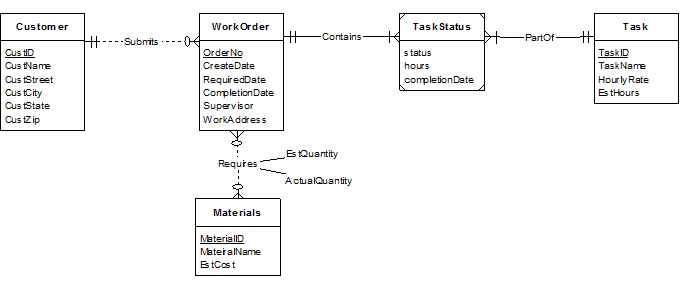Instructions: You may draw the diagrams using any program. HOWEVER, the constructs must conform to the Crow’s Foot diagramming conventions.
1. For question 1, turn in 3 ER diagrams.
a. Draw an ERD containing Patient, the Physician and Visit entity types connected by 1-M relationships from Patient to Visit and Physician to Visit. Choose appropriate names for the relationships. Define minimum cardinalities so that Patients and Physicians are mandatory for a Visit but Visits are optional for Patients and Physicians. For the Patient entity type, add attributes PatNo (primary key), PatFirstName, PatLastName, PatStree, PatCity, PatState, PatZip and PatHealthPlan. For the Physician entity type, add attribues PhyNo (primary key), PhyFirstName, PhyLastName, PhySpecialty, PhyPhone, PhyEmail, PhyHospital, PhyCertification. For the Visit entity type, add attributes VisitNo (primary key), VisitDate, VisitPayMethod, and VisitCharge. You do not need to specify datatypes.
b. Draw a second ERD. Extend the ERD from 1.a. with the Nurse, the Item and the VisitDetail entity types connected by 1-M relationships between Visit to VisitDetail, Nurse to VisitDetail, and Item to VisitDetail. VisitDetail is a weak entity with the 1-M relationship from Visit to VisitDetail an identifying relationship. Choose appropriate names for the relationships. Define minimum cardinalities so that a Nurse is optional for a VisitDetail, an Item is mandatory for a VisitDetail, and VisitDetails are optional for Nurses and Items. For the Item entity type add attributes ItemNo (primary key), ItemDesc, ItemPrice and ItemType. for the Nurse entity type, add attributes NurseNo (primary key), NurseFirstName, NurseLastName, NurseTitle, NurseSpecialty, NursePhone and NursePayGrade. For the VisitDetail entity type, add attributes for the DetailNo (part of the primary key), and DetailCharge.
c. Draw a third ERD. Refine the ERD from 1.b. with a generalization hierarchy consisting of Provider, Physician and Nurse entity types. The supertype of the Generalization hierarchy is the Provider. The primary key of Provider is ProvNo, replacing the attributes PhyNo and NurseNo. The other attributes in Provider should be the attributes in common between Physician and Nurse (rename them to be consistent with the Provider entity type). A provider must be either a Nurse or a Physician but cannot be both.
d. Check your diagram for violations of the completeness and consistency rules (Table 5.4). Now, draw a fourth ERD to modify your diagram to add violations of Completeness Rule 3, and of Consistency Rules 3, 8 and 9. Make a list of those violations.
2. “Read” the relationships of the following diagram, being sure to include in the statements phrases to express both minimum and maximum cardinality for each relationship.

3. Convert the following Generalization–Specialization diagram into relational tables. Show THREE different ways that you can do this. Show the table SCHEMAS but NOT the CREATE TABLE statements.

4. Convert the following diagram into relational database tables. You do not need to list the conversion rules. Show the table SCHEMAS but NOT the CREATE TABLE statements.

5. Convert the following diagram into relational database tables. You do not need to list the conversion rules. Show the table SCHEMAS but NOT the CREATE TABLE statements.
